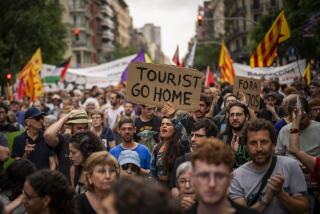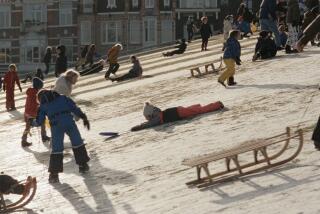Well above the fray in Utrecht
Utrecht, Netherlands
The first thing you notice about Utrecht is the Dom. Soaring 336 feet, the church tower, said to be the tallest in the Netherlands, is the city’s centerpiece. At first it seems almost too big to stand above the quiet canals and streets, as though the size of the town never expanded to the grandness the tower promises.
But after spending a little time in this, the oldest Dutch city, I realized that it all fits together nicely.
I arrived in Utrecht after a 30-minute train ride from Amsterdam. Spring was just coming into full bloom in this city in the central Netherlands, and it seemed a good time for my boyfriend, Simon, and me to visit a Dutch friend and get away from the debauchery of Amsterdam. Its excesses are appealing initially, perhaps, but one can take only so many inebriated soccer fans and stoned backpackers. One night in the Dutch capital, complete with choruses of police and fire sirens, was enough for us, so we headed for Utrecht.
Here in this city of tree-lined canals and medieval buildings, the noise comes from chirping birds and church bells. Because Utrecht is smaller than Amsterdam, it’s even easier to explore on foot, but it still has plenty of fine restaurants, shops and other amenities. If Amsterdam is Los Angeles, Utrecht is Santa Barbara, the mellower, hippie-chic neighbor.
Although there’s no surf in Utrecht, water is nonetheless an essential element of its charm. The most distinctive features of this city of nearly 250,000 — besides the Dom — are its canals. Water, of course, is prevalent in the Netherlands, where a large part of the country is technically below sea level and the waterways keep the land drained.
Utrecht is bisected by two canals, the Oudegracht and the Nieuwegracht, or the old and new canals, built in the 11th and 14th centuries. A third canal, called the Singel, surrounds the city. The Amsterdam Rijn Canal passes to the south of Utrecht and turns toward the capital.
To prevent flooding, city officials raised the ground level. In the 13th century, wharves and warehouses were constructed below the street and along the canal for merchants to unload and store their goods. What were once loading docks and storage areas are now restaurants, cafes and bars, with the streets and shops 15 feet above.
Once the weather turns warm, the terraces are packed with locals and tourists, who can enjoy cuisine as varied as Thai red curry and Spanish tapas. The warmer the weather, the more boats there are, sometimes even causing a canal boat jam.
For a different perspective on a city in which water plays an important role, you can take a narrated historical boat tour or, as we did, rent a paddle boat (called a “canal bike” in the Netherlands) for about $6 a person. That allowed us to see the city at our own pace, and although the pedaling sometimes seemed tougher than a spinning class, the views were worth the effort as we passed beneath brick bridges and ornamental sculptures and soaked up the historic ambience.
In AD 47, Roman Emperor Claudius ordered a series of fortresses built along the Rhine to protect the northwest border of the Roman Empire. Among them was what is today Utrecht. As centuries passed, the town was visited often by various Holy Roman emperors. As a result, churches were erected, and the city was increasingly used as a hub for promoting Christianity.
Utrecht was also at the center of war and peace over the centuries. Napoleon used the city to help wage his campaigns. And it was the site of the Treaties of Utrecht, which, among other things, ended the complex War of Spanish Succession in 1713 and 1714.
Through it all, the Dom was at its center.
Construction began in 1321 for what was to have been the tower of the 11th century St. Martin’s Cathedral. By the 1500s, the tower and the bulk of the church had been built, but the center part — needed to connect the tower and the choir — was still missing. Money was short, as was interest in completing the project, so the connecting piece was hastily and cheaply erected.
On a summer evening in 1674 a hurricane whipped through the town, and, within minutes, most of Utrecht’s towers were heavily damaged or destroyed. Among the wreckage was the poorly built middle piece of St. Martin’s. The Dom and the rest of the church survived and still stand.
To explore the tower, you can climb the 465 steps to the top on a guided tour. You stop several times along the way, but the walk is tough. Still, I found the view from the top well worth it for the panorama of the city and the surrounding countryside.
The bells that ring on the quarter hour sound much lovelier wafting through the streets of Utrecht than they do when you are standing next to them. I was reminded of my days in the junior high school band when we all played as loudly as possible even though we were horribly out of tune.
Once my head cleared, I decided to pick up a walking tour booklet for about $3.50. (Guided tours of the city are also available starting from the Dom.) This easy-to-follow guide is packed with historical information and a map. It also lists Utrecht’s 10 museums, which feature items as diverse as aboriginal art and a history of the Dutch railways.
On my self-guided tour, I particularly enjoyed the garden where St. Mary’s church once stood. At the end of the 11th century, Henry IV built a church dedicated to St. Mary. Henry was said to have been so irate that the St. Mary’s in Milan, Italy, had been destroyed by his own army that he spared no effort or expense to build a new one.
With vaulted ceilings, wide aisles and two striking towers, the church was said to have been as stunning as the most beautiful churches in northern Italy. It remained a jewel of the city until the early 1800s, when Napoleon gave his brother Louis the newly created Kingdom of Holland. The brothers quarreled continually about running it. In the summer of 1810, Napoleon took it back.
Running short on money, Napoleon sold St. Mary’s for less than $10,000 to help fund his army. As he entered the battle of Leipzig, early one November morning in 1813, St. Mary’s was demolished. It was, perhaps, a double-edged sword for the Dutch. Though the battle meant the loss of their beloved St. Mary’s, it also marked the end of French occupation. After Napoleon’s defeat at Leipzig, he withdrew from Utrecht and its nation.
A garden respite
A large garden called the Pandhof Sinte Marie is the only piece that remains of St. Mary’s. The garden is separated into seven sections, each growing different plants. One section has medicinal plants; another has Mediterranean flowers.The garden, which sits behind a music school and is near the city’s central train station, is an enjoyable place to take a break from tower climbing and canal biking. I enjoyed a favorite Dutch snack — French fries with mayonnaise and onions — and listened to music students rehearse.
Students play a central role in Utrecht; the city is home to Utrecht University, founded in 1636 and one of the country’s leading institutions of higher learning. Students make up about 20% of Utrecht’s population, which perhaps accounts for much of the young and young-at-heart feeling here.
You can see it in the shops that sit along the Oudegracht, where you can look for snowboards or for antiques. One store specializes in rare books, and the next has magic mushrooms.
The train station complex houses the largest shopping mall in the country, though it’s smaller than most American malls. Banners tout it as the “shopping heart of the Netherlands,” but locals acknowledge that they wish the city would either give the awkward and unattractive mall a much-needed face-lift or get rid of it.
The mall houses predictable European chain clothing stores, and it’s a fine place to buy a sandwich for the train ride, but the best shopping is in the city center, just beyond the train station. Shopkeepers are friendly and not put off by English-only speakers (as they can be in some European destinations). The Dutch will often immediately and happily begin speaking English the moment they realize you don’t speak Dutch. Their English is so good that I started to joke that Dutch people seem to be native English speakers who also know Dutch very well.
The busiest shopping stretch is along the Oudegracht closest to the train station, which has name-brand stores and is perhaps too modern for this medieval city. But if you keep walking along the old canal away from the train station, the stores have more taste and fewer logos.
I found a few good used-book stores, which have English titles mixed in with Dutch texts. And there are some great deals to be found if, like me, you need to restock your reading material midtrip. Antique furniture stores, modern art galleries and even a tattoo and piercing parlor won me back after the disappointing train station mall.
When I first visited and traveled through the Netherlands nearly a decade ago, the people I met were fascinated by and enchanted with meeting an American. They often asked about movies and celebrities. Now the questions have a more serious and critical political tone. Many of the Dutch I met didn’t hold back, and that bluntness can seem harsh. On the upside, it’s easy to strike up a conversation.
One evening Simon and I agreed to go for a beer with a Dutch friend in a quiet little bar just outside the city center. Before we were half finished with our first drink, the bartender was already offering a second. Why not? Sure, we’ll have another round. Soon our friend introduced us to the regulars, who wanted to know where we were from and why we were staying in Utrecht rather than Amsterdam. Before we knew it, one beer had turned into several, and we had made new friends.
Beery brand loyalty
Like their Belgian neighbors, the Dutch have a strong beer culture. Heineken may be the best-known Dutch beer in the States, but the Dutch are typically prouder of Grolsch, which they see as a worker’s brew.The Dutch also argue — and I tend to agree — that Grolsch has more flavor than Heineken. As one friend put it, you know you are drinking beer when you’re having a Grolsch, but Heineken is closer to beer-flavored water.
Whatever your drink, having it on one of Utrecht’s terraces is an important part of soaking up the ambience. If the sun is out, you may have a hard time snagging a table because locals do not miss a chance to sunbathe and be seen. If you are going for a coffee or a beer, stake out some territory and enjoy the people watching.
As in most European countries, dinner in the Netherlands can be a lengthy social occasion. Utrecht’s Oudegracht has a range of international cuisines, perhaps encouraged by the large immigrant population. In fact, foreign foods seem more prevalent than the local fare. We enjoyed a large Indian meal at Thipan restaurant on the old canal, filling ourselves with chicken tikka and naan bread. Another night we ate in the cellar of ‘t Oude Pothuys restaurant, which focuses on fondue and also hosts late-night live music.
In spring and summer it stays light late into the evening, making dinner next to the old canal that much more enjoyable. Restaurants generally close by 11 p.m., and if you find yourself still deep in conversation, the waiter will give a small hint that it is time to leave by quietly placing your check on the table. Tips are optional; in the Indian restaurant, our waiter followed us outside saying that we had accidentally left some money on the table. That is the tip, we explained, to his delight.
One night we skipped dinner entirely and attended Museum Night, an event aimed at promoting culture by giving admission to all the city’s museums until 2 a.m. for $17.
I expected quiet, pensive strolls through art exhibitions broken up by glasses of white wine. But this was more of a party than a stuffy cultural event. Every museum had entertainment — flame throwers, free samples of chocolate-covered roasted grasshoppers, a chance to have your aura read.
The railway museum was transformed into a haunted house, and we screamed as we walked through the darkened old train cars filled with goblins. At the medieval convent, the silent disco gave us a big laugh as dancers jamming with wireless headphones on sang “Y-M-C-A!” but we heard no music.
It was an evening that, like Utrecht, offered the pleasure of the unexpected.
*
Jennifer Hamm is a Europe-based freelance journalist.
More to Read
Sign up for The Wild
We’ll help you find the best places to hike, bike and run, as well as the perfect silent spots for meditation and yoga.
You may occasionally receive promotional content from the Los Angeles Times.






